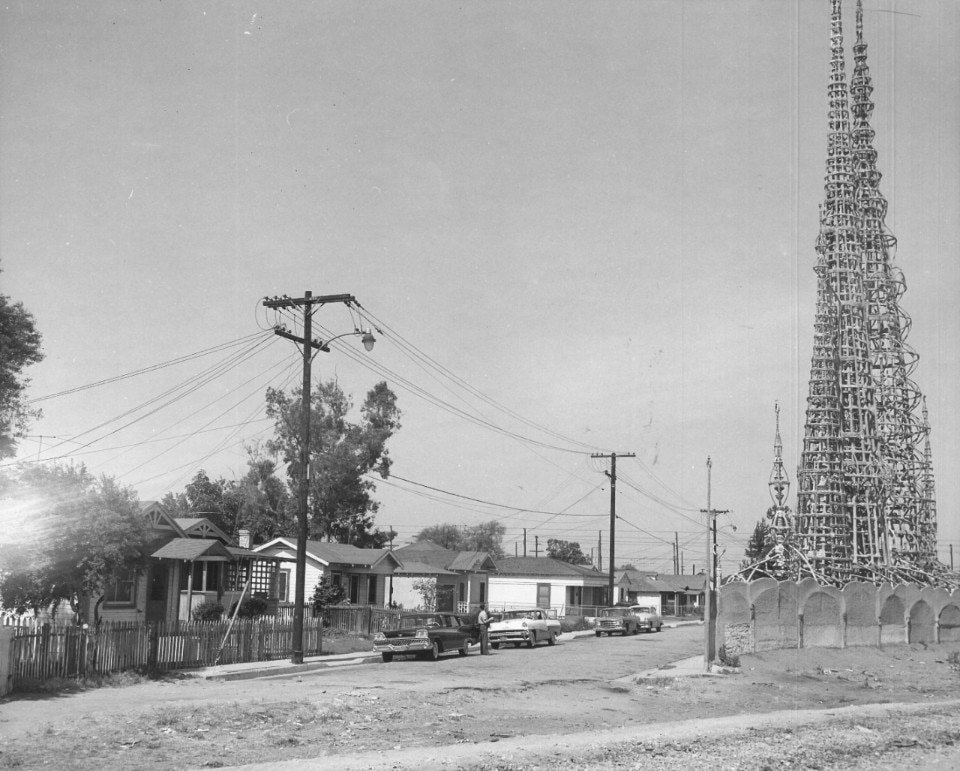THE AMAZING TOWERS OF WATTS
LOS ANGELES — 1921 — The narrow streets of South Central were home to recent immigrants -- Japanese and Mexican, Filipino and Greek -- but there was one “Eye-talian” and some thought him crazy. A little guy, lean and wiry, he spent every evening in his backyard building, building. Asked what he was building, he just said, "something big."
The construction began as a gazebo, fluted curves coated in cement and pressed with sea shells, pottery shards, green glass from pop bottles. A gazebo seemed sane enough. But then the towers began to rise.
For the next three decades, Sam Rodia kept building. Neighbors saw the little man, his bucket dangling, climbing sixty, seventy, eighty feet in the air. Perched high above the street, he smoothed cement over bent steel, then pressed more shells, more shards into wet concrete. The towers reminded some of sand castles, but most had never seen anything like them.
Today, the Watts Towers are more famous in Europe than in America. But a century after Sabato "Sam" Rodia went to work, his towers remain proud, celestial, unique. "The Rodia Towers," one sculptor said, "are as pure a work of art as this country can rightly call its own."
Beyond superlatives, the Watts Towers beg a question: How did one man, without training in art or engineering, without power tools or scaffolding, handcraft the largest structure on earth made by a single builder? Then comes the deeper question -- why?
Sabato Rodia was born near Naples in 1879. His parents were peasants making enough to raise three children, but not four. So in the 1890s, the eldest brother left for "L'America." Landing a job in a coal mine, Ricardo Rodia sent for 14-year-old Sabato, who in homage to his adopted country, changed his name to Sam.
Ricardo soon died underground, one of a thousand miners killed each year. His brother’s death cut Sam loose. He drifted west, landing in Seattle where he married and had three kids. The Rodias soon moved to Oakland where Sam took to drink.
"I was one of the bad men in the United States," he recalled. "I was drunk all the time, always drinking." When he and his wife separated, Sam headed to L.A. where he married again, divorced again, and finally quit drinking. Saving $900, he bought a house in Watts and moved in with another woman. But she hated the rattling street cars and dusty fields. And Sam had begun building strange cement sculptures. She left in 1921, taking his last human love, and his opera records.
He was forty-two, barely literate, unskilled beyond basic tasks from a life of labor. To this day no one is sure why, but late in 1921 he began "something big." "You have to be either good good or bad bad to be remembered," he often said. "You gotta do somethin' they never got 'em in the world." He began by digging a foundation.
A ten-story structure should have a foundation as deep as a basement, but Rodia dug just a shovel's width wide and two feet deep. With foundation in place, he moved the only way the lot would allow -- upward into his dreams.
The Depression ended. The war was fought and won. But month after month, the little man built higher. Back on the ground, he added cosmetic touches, imprinting his tools, his initials, the year 1921 on arches.
Then in the summer of 1954, Rodia fell off a tower. The fall was from a low height but at 75, he sensed the end. Two weeks later, he gave his house to a neighbor, boarded a bus and never returned.
Though the towers had withstood time and earthquakes, city engineers were concerned. In 1957 they slated the towers for demolition, leading local artists to form the Committee to Save the Watts Towers. Hearings. Studies. More hearings. Sure, the towers were unique, but were they safe?
On an October day in 1959, a steel cable was bolted to the tallest tower, topping 100 feet. At a signal, the winch began to pull. And pull. The tower stood. When the winch lifted into the air, the test was called off. The demolition was canceled.
Artists and newspapers soon touted the amazing towers built by the little man who had disappeared. Then in 1961, Rodia was discovered living in Martinez, California. In his eighties, with a shock of white hair, he sat unnoticed at a Berkeley art show as slides of his towers were shown. When the lights went up, Sam Rodia stood to his full 4' 10". The audience stood, too, for wave after wave of applause. He bowed and tipped his hat.
Sam Rodia died in 1965. Today his towers draw 40,000 visitors a year. Filing past the kaleidoscopic outer wall, people gaze up at spidery loops and rings, then lower their eyes to the multi-colored fountain, the mosaic ship, the wonder of it all.
"Think of that little guy, all by himself," another sculptor said. "Not a penny from it, not a penny. We don't have those people anymore. It's a miracle, a thing like that. It happens once in a million years.”
















